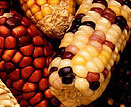 |
 |
|||||||||
|
Feeding the WorldAgricultural Research, USDA/ARS Some might say that Dr. Norman Ernest Borlaug, Nobel Peace Prize winner in 1970 and respected agricultural scientist, was destined for greatness. For evidence, they might point to the name of his hometown in Iowa: Cresco. In Spanish, crezco, pronounced similarly to Cresco, means "I grow." Indeed, Borlaug's entire life and research have been about growing. He is recognized the world over as the father of the "Green Revolution," a term that refers to marked increases in cereal-grain production that began in the late 1960s. "Back in the late thirties and early forties, I didn't have any idea that my work would have the impact that was achieved by the so-called Green Revolution," Borlaug said from Texas A&M University in College Station, where he gives special lectures and has a building named in his honor. "I didn't have any intentions of going into international agriculture. My education and work was originally in forestry with the U.S. Forest Service." At this month's inaugural Henry A. Wallace Inter-American Scientific Conference Series at CATIE, in Turrialba, Costa Rica, an international body of scientists and agricultural policymakers will hear the Nobel laureate talk about his views on research and food technology. As time marches along in this young millennium, improving food technology is vital to a world populated by more than 6 billion people and growing by 80 million each year. He is in favor of harnessing biotechnology to help address the world's food shortages. ARS and CATIE are excited to have at their conference this distinguished scientist, who has a lengthy list of honors, accomplishments, and work experience. The first major assignment of Borlaug's professional career took him to Mexico, where he organized and directed the Cooperative Wheat Research and Production Program. That was part of an initiative linking the Mexican government with the Rockefeller Foundation. There, Borlaug oversaw foundation research in genetics, breeding, plant pathology, entomology, agronomy, soil science, and cereal technology. It was his work in Mexico that began Borlaug's humanitarian goal of feeding the world's indigent. While predictions of an overpopulated world with little food to eat entered the mainstream-boosted by the 1968 best-seller The Population Bomb-Borlaug helped feed the poor through his research on dwarf wheat varieties that resisted pathogens and pests while yielding two to three times more grain than regular wheat. From those innovations, wheat production in various countries skyrocketed. Yields rose from 4.6 million tons to 8.4 million in Pakistan between 1965 and 1970. India's totals for the same period rose from 12.3 million to 20 million. India has recently harvested more than 73.5 million tons of wheat. From that work, the Rockefeller Foundation and Mexico began the International Maize and Wheat Improvement Center (CIMMYT). While investigating crop and plant problems there is a top priority, Borlaug used new funds to help create a highly productive internship. At last count, more than 1,900 young scientists from 16 different countries had worked with CIMMYT. Today, Borlaug is a distinguished professor with many involvements. Through the Carter Center's Global 2000 program, Borlaug and former U.S. President Jimmy Carter work together to help more than an estimated 4 million small-scale farmers in 11 sub-Saharan countries improve food production. After all these years, his work is still creciendo (growing).-By Lupe Chavez, formerly with ARS.
|
|